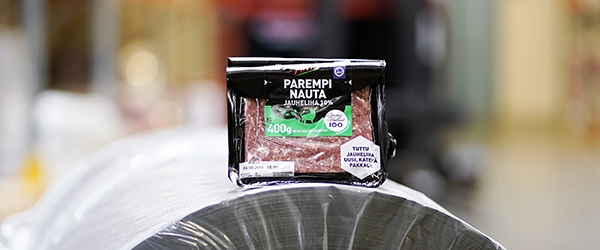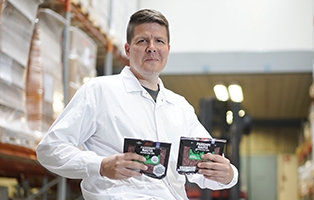Atria’s well-thought-out packaging

 Packaging Development Manager Janne Hautala has worked at Atria since 2001 and been involved in product packaging since he started.
Packaging Development Manager Janne Hautala has worked at Atria since 2001 and been involved in product packaging since he started.
“I joined the company at a time when the development of packaging really took off,” says Hautala.
One of Hautala’s first tasks was to develop packaging for cold cuts.
“We paid particular attention to user-friendliness, and consumers liked our new packaging very much. Prompted by this, our competitors started similar development processes.”
Atria uses more than 200 million bits of packaging every year, if we include packaging used in the retail sector and commercial kitchens. The company has invested more resources in the development of packaging since the beginning of the 2000s.
Packaging sells and protects
When Atria’s team develops new packaging, it makes sure the packaging is usable, recyclable and looks good. The appearance of packaging and the images it presents affect consumers’ decision to buy a particular product.
“It’s really important to emphasise the brand,” says Hautala.
Packaging that is easy to sell must also be easy to recycle. The fact that Atria’s packaging is often made of plastic and plastic laminates poses challenges, and Hautala admits that Atria’s packaging is not the easiest in terms of recycling.
“The packaging’s most important function is to protect the product. The product must reach consumers undamaged.”
Packaging can only be made thinner and lighter to a certain extent, as the storage life of the product must be secured during transport and storing at home.
“Mechanical protection is a priority as well as a question of product safety.”
The amount of plastic used is reduced
Consumers, like Atria, value sustainable development. New packaging for minced meat that is considerably more eco-friendly than the previous packaging method was launched early this year.
“We save significant amounts of material by using the new packaging,” Hautala explains.
Atria produces large amounts of minced meat so the amount of material used for packaging is also considerable.
“Using a lighter material really does make a difference. With the new packaging, we use 100,000 kg less plastic than before.”
The development process of the new minced meat packaging took years. New packaging sometimes requires enormous investments in new equipment, and this was the case here.
“Machines and equipment are expensive to acquire, yet the price of food is coming down. It is a complex equation for us,” Hautala admits.
The design of new packaging starts with a meeting between designers and professionals of the packaging and production sectors. A specialist from the company supplying the packaging material is also involved in the design process.
“It’s a collaboration between a number of parties and can be quite complicated. For example, we buy our machines from overseas. We have, however, managed to overcome all the obstacles.”
Food must keep perfectly in its packaging
The final packaging is the sum of several elements. The starting point is the product in the packaging: it must be of the highest quality. The best packaging is one that supports the product and the product’s usability.
“The packaging must stand out on the shelf and be easy to pick up. It mustn’t take too much space, yet it needs to have a big enough surface for labels and print so it is visible among the other products on the shelf. Every new packaging is tested with consumers before it is launched on the market.”
The new packaging for minced meat attracted great attention when it came into supermarkets. Its development started with a consumer survey about five years ago. Minced meat had been packed in the same type of container for more than ten years, and a change was needed.
“We knew that a product’s shelf life can be extended in vacuum packaging. We also knew that this would take less space and reduce the number of boxes and truck loads required to move the product around. So it was clear that the change would generate numerous benefits.”
Consumers’ reaction raised questions.
“We tested minced meat packed in vacuum packaging with a team of consumers years ago, but they did not like the changes in the meat’s colour. When we decided to retest the packaging, the outcome was different. People found that the advantages outweighed the disadvantages: the packaging takes very little space and is easy to dispose of. The consumers’ views helped us a lot.”
When the consumers’ opinions had been assessed, the design for the new packaging was drafted and suppliers of the machinery were involved in the process.
“It’s the duty of our packaging development organisation to ensure that the solutions work in production and distribution.”
Development continues
Janne Hautala says that Atria’s black packaging is still a challenge to the recycling process as the infrared cameras in the recycling equipment do not recognise black plastic. The sensors can be improved, however, and this is what Atria has done.
“We have had to readjust the sensors at our plant as we have black and transparent packaging in our production. We use black plastic because it’s our brand colour and important to us.”
Hautala points out that it is difficult for the industry to make decisions on the packaging colours based on the sensor technologies:
“In terms of marketing, we have to consider what type of packaging sells. Packaging has particular colours for a reason.”
27.9.2017
Text Jussi Mustikkamaa
Photos Timo Aalto